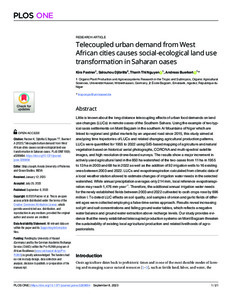| dc.date.accessioned | 2023-11-24T08:30:47Z | |
| dc.date.available | 2023-11-24T08:30:47Z | |
| dc.date.issued | 2023-09-08 | |
| dc.identifier | doi:10.17170/kobra-202311249073 | |
| dc.identifier.uri | http://hdl.handle.net/123456789/15211 | |
| dc.description.sponsorship | Gefördert durch den Publikationsfonds der Universität Kassel | |
| dc.description.sponsorship | Funding by University of Kassel (Germany) and by the German Academic Exchange Service (DAAD) within the Pro-RUWA program of African Excellence (www.uni-kassel.de/go/Pro- RUWA) is greatly acknowledged. | |
| dc.language.iso | eng | |
| dc.rights | Namensnennung 4.0 International | * |
| dc.rights.uri | http://creativecommons.org/licenses/by/4.0/ | * |
| dc.subject.ddc | 630 | |
| dc.title | Telecoupled urban demand from West African cities causes social-ecological land use transformation in Saharan oases | eng |
| dc.type | Aufsatz | |
| dcterms.abstract | Little is known about the long-distance telecoupling effects of urban food demands on land use changes (LUCs) in remote oases of the Southern Sahara. Using the example of two typical oasis settlements on Mont Bagzam in the southern Ar Mountains of Niger which are linked to regional and global markets by an unpaved road since 2015, this study aimed at analyzing time trajectories of LUCs and related changing agricultural production patterns. LUCs were quantified for 1955 to 2022 using GIS-based mapping of agriculture and natural vegetation based on historical aerial photographs, CORONA and multi-spectral satellite images, and high resolution drone-based surveys. The results show a major increment in actively used agricultural land in the 850 ha watershed of the two oases from 11 ha in 1955 to 13 ha in 2003 and 68 ha in 2022 as well as the addition of 92 irrigation wells to 16 existing ones between 2003 and 2022. LUCs and evapotranspiration calculated from climatic data of a local weather station allowed to estimate changes of irrigation water needs in the selected watershed. While annual precipitation averages only 214 mm, local reference evapotranspiration may reach 1,476 mm year-1. Therefore, the additional annual irrigation water needs for the newly established fields between 2003 and 2022 cultivated to cash crops rose by 696 million l. To detect LUC effects on soil quality, soil samples of onion and garlic fields of different ages were collected employing a false-time-series approach. Results reveal increasing soil pH and salt concentrations and falling ground water tables, which reflects a negative water balance and ground water extraction above recharge levels. Our study provides evidence that the newly established telecoupled production systems on Mont Bagzam threaten the sustainability of existing local agricultural production and related livelihoods of agropastoralists. | eng |
| dcterms.accessRights | open access | |
| dcterms.creator | Fastner, Kira | |
| dcterms.creator | Djibrilla, Salouhou | |
| dcterms.creator | Nguyen, Thanh Thi | |
| dcterms.creator | Bürkert, Andreas | |
| dc.relation.doi | doi:10.1371/journal.pone.0289694 | |
| dc.subject.swd | Afrika | ger |
| dc.subject.swd | Nordafrika | ger |
| dc.subject.swd | Landwirtschaft | ger |
| dc.subject.swd | Oase | ger |
| dc.subject.swd | Beeinflussung | ger |
| dc.subject.swd | Gesellschaft | ger |
| dc.subject.swd | Lebensmittelnachfrage | ger |
| dc.subject.swd | Stadt | ger |
| dc.type.version | publishedVersion | |
| dcterms.source.identifier | eissn:1932-6203 | |
| dcterms.source.issue | 9 | |
| dcterms.source.journal | Plos One | eng |
| dcterms.source.volume | 18 | |
| kup.iskup | false | |
| dcterms.source.articlenumber | e0289694 | |


